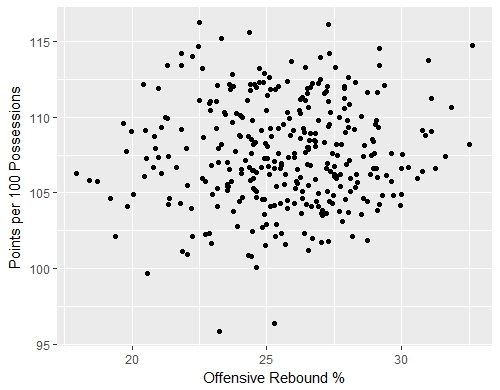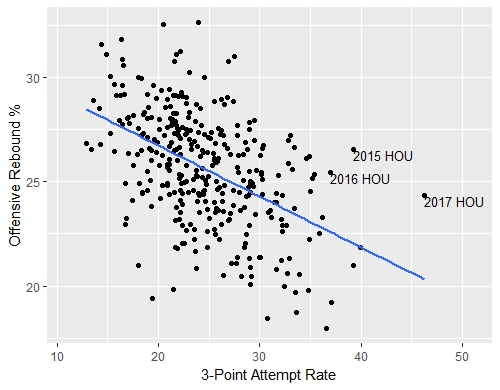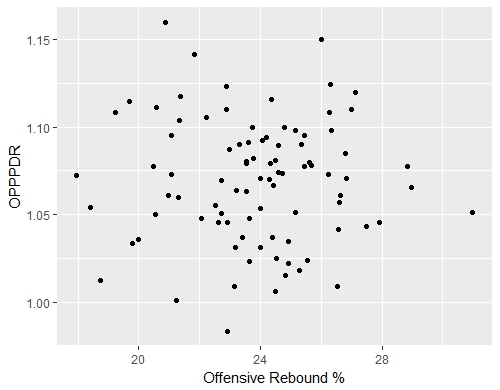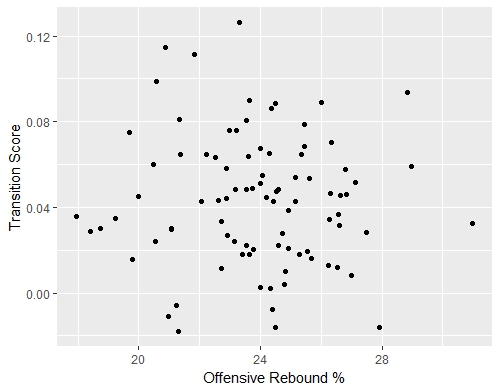In the seconds immediately following a shot attempt, the players on offense can take one of two actions: (1) get back on defense to prevent a potential transition bucket from your opponents, or (2) crash the paint to get in position for an offensive rebound. In the article below, I explore the positive and negative impacts of each option.
Do more offensive rebounds lead to more efficient offense?
Offensive rebounds can be an effective way for teams to steal extra possessions and get higher-percentage shot attempts. In the 2016 NBA finals, the Cavaliers consistently punished the smaller Warriors by getting offensive rebounds, and this (along with a nut-punch, questionable officiating, and very timely shooting) was a key reason they were able to defeat Golden State. However, teams that chase offensive rebounds can be left more vulnerable in transition if their opponents decide to push the pace after securing a rebound on defense. This cost and benefit balance of chasing offensive rebounds is something that all coaches must wrestle with. In recent years, teams have been getting less and less offensive rebounds. The league average offensive rebound percentage has dropped steadily from 31.8% in 1990 to 23.1% in 2017. This is largely driven by the changing shot selection in the NBA, especially for big men. Centers and Power Forwards are shooting more threes and posting up less (e.g.,Kevin Love or Kristaps Porzingis) which is leaving them with fewer opportunities to get offensive rebounds. This decrease is also due to the fact that coaches are emphasizing getting back on defense as more teams are pushing the pace in transition.
How valuable are offensive rebounds? In the 2017 season, teams scored 1.22 points per possession on possessions where they got an offensive rebound, almost as high as the 1.24 points per possession that was scored off of steals that season. Clearly, offensive rebounds are still quite valuable, but it is difficult to quantify how gaining more or less offensive rebounds changes a team’s offensive output. The plot below shows points per 100 possessions by offensive rebound percentage. There doesn’t appear to be a very strong relationship between the two.
On average, as offensive rebound percentage increases by 1, teams score 0.072 more points per 100 possessions, but this relationship is not significant with a p-value of just 0.31. Why is this relationship so week? It could be that teams that are already high scoring just choose not to pursue offensive rebounds. Or it could be that high scoring teams tend to shoot more three pointers and don’t have as many opportunities to be in position for an offensive rebound. In order to test this theory, we can add three point attempt rate to account for variation in three point attempts:
Now, the effect of offensive rebounding on points per 100 possessions is MUCH more significant! On average, as offensive rebound percentage increases by 1, teams score 0.36 more points per 100 possessions, while holding three point attempt rate constant. This relationship is quite significant with a p-value < 0.01. Clearly, the recent surge in three point shooting has also effected offensive rebounding. We can see how strong this relationship is in the plot below, which shows offensive rebound percentage by three point attempt rate for all teams since 2007:
There is a strong negative correlation between a team’s three point attempt rate and their offensive rebound percentage (![]() ). This suggests that a drawback of shooting a large volume of three point shots is getting fewer extra possessions from offensive rebounds. The exception to this rule is every NBA data-geek’s favorite team, the Houston Rockets. Over the past three years, the Rockets have embraced the three point shot more than any other team in the league, and shot an all-time high 46.2% of their shots from behind the arc last season. Even with so many long range shots, the Rockets are maintaining reasonably high offensive rebound percentages. Last year, they rebounded 24.6% of their missed shots, above the league average! Clearly, the Rockets are still making a concerted effort to secure offensive rebounds even as they continue to push their three point attempts to new levels each year.
). This suggests that a drawback of shooting a large volume of three point shots is getting fewer extra possessions from offensive rebounds. The exception to this rule is every NBA data-geek’s favorite team, the Houston Rockets. Over the past three years, the Rockets have embraced the three point shot more than any other team in the league, and shot an all-time high 46.2% of their shots from behind the arc last season. Even with so many long range shots, the Rockets are maintaining reasonably high offensive rebound percentages. Last year, they rebounded 24.6% of their missed shots, above the league average! Clearly, the Rockets are still making a concerted effort to secure offensive rebounds even as they continue to push their three point attempts to new levels each year.
Brian Skinner from gravityandlevity.com wrote a great article in which he dug into the math behind offensive rebounding. He investigates how much teams would gain offensively by improving their offensive rebound rate, and he describes a new metric he created called VIOR (Value of Improved Offensive Rebounding). This metric represents the number of points per 100 possessions that a team’s scoring should increase if their offensive rebound rate increases by 1 percent. One of his theories is that teams that shoot a high proportion of threes should have a higher VIOR because teams that shoot a lot of threes tend to have a higher level of offensive efficiency (i.e., each possession is worth more), and because they have more missed shots (i.e. more opportunities for offensive rebounds). More simply, he’s saying that offensive rebound percentage should have a stronger effect on a team’s points per 100 possessions as the three point attempt rate increases. In order to test this theory, I fitted a model to predict offensive rating by offensive rebound percentage, 3-point attempt rate, and an interaction between the two. I used data aggregated at the season level for each team from 2007 – 2017.
Offensive Rating = 84.6 + 0.55(3-pt attempt rate)
+ 0.6(offensive rebound pct) + -0.009(3-pt attempt rate * offensive rebound pct)

The model shows that as offensive rebound percentage increases by 1, offensive rating increases by 0.6 + -0.009*(3-pt attempt rate). This means that the effect of offensive rebounding on offensive rating decreases as 3-pt attempt increases, exactly the opposite of what Skinner suspected. Although, it should be noted that the interaction term is not significant (p-value of 0.4). The data shows that teams do not get more value from offensive rebounds as they attempt more 3-point shots. However, it still could be true that there exists more opportunities for teams to score off of offensive rebounds as they shoot more threes, but they are failing to capitalize due to style of play and strategy.
How does offensive rebounding effect defense?
The other side to this equation is transition defense. The pace of play in the NBA has been steadily increasing since the mid-2000s, which is making it more and more important for teams to get back on defense to stop their opponent from getting easy scoring opportunities. Elite playmakers like Russell Westbrook, Stephen Curry, John Wall, and Raymond Felton (just seeing if your paying attention) can turn a rebounded shot into a basket in the blink of an eye. Coaches, by nature, tend to be more conservative minded, and nothing used to make my coaches more upset then getting beat back on defense after a missed shot. The question here is, does the value gained from offensive rebounds outweigh the value given up to opponents in transition points? To answer this question, I used data from basketball reference’s play-by-play game logs from the 2015 – 2017 NBA regular seasons to calculate the points per possession that teams gave up following their opponents’ defensive rebounds. If teams are having more players crash for rebounds instead of getting back on defense, then their opponents should consequently get more easy baskets in transition following defensive rebounds. The following plot shows opponent points per possession following defensive rebounds by offensive rebound percentage, or OPPPDR.

As we can see from the random scattering of the data points in the plot above, there is no significant relationship between a team’s offensive rebound percentage and their opponents points per possession off defensive rebounds (![]() ). However, we are missing a key ingredient here – how well do teams defend generally? A high or low OPPPDR might be more driven by overall team defense than by how well a team gets back in transition. To account for this, I created a metric I call transition score. which is the difference in opponent points per possession scored off of defensive rebounds and the opponent points per possession scored off of made baskets. This metric should capture how well a team defends in transition (following a defensive rebound) in comparison to how well they defend in the half court (after a made shot). For reference, the average transition score in 2017 was 0.045. That means that, on average, teams gave up 0.045 more points per possession following defensive rebounds than made baskets. The plot below shows transition score by offensive rebound percentage.
). However, we are missing a key ingredient here – how well do teams defend generally? A high or low OPPPDR might be more driven by overall team defense than by how well a team gets back in transition. To account for this, I created a metric I call transition score. which is the difference in opponent points per possession scored off of defensive rebounds and the opponent points per possession scored off of made baskets. This metric should capture how well a team defends in transition (following a defensive rebound) in comparison to how well they defend in the half court (after a made shot). For reference, the average transition score in 2017 was 0.045. That means that, on average, teams gave up 0.045 more points per possession following defensive rebounds than made baskets. The plot below shows transition score by offensive rebound percentage.

Again, there appears to be no relationship between transition score and offensive rebound percentage. Teams that are getting offensive rebounds at a higher rate are not giving up more points in transition in comparison to their half court defense (![]() ). Does crashing the glass for offensive rebounds really not have a significant effect on transition defense? Possibly. It could also be true that the variation in team offensive rebound percentage is more due to individual player ability than it is to team strategy. For instance, if every team in the NBA typically sends four players back on defense while one player chases an offensive rebound, then offensive rebound percentage is solely defined by that one player’s ability to secure rebounds. For future research, It would be interesting to see how many offensive players choose to get in position to rebound versus get back on defense, and what the implications of these different strategies are.
). Does crashing the glass for offensive rebounds really not have a significant effect on transition defense? Possibly. It could also be true that the variation in team offensive rebound percentage is more due to individual player ability than it is to team strategy. For instance, if every team in the NBA typically sends four players back on defense while one player chases an offensive rebound, then offensive rebound percentage is solely defined by that one player’s ability to secure rebounds. For future research, It would be interesting to see how many offensive players choose to get in position to rebound versus get back on defense, and what the implications of these different strategies are.
Conclusion
Offensive rebound percentage has been steadily declining for a long time in the league as three point shooting volume has skyrocketed. Big men are trading post-ups for three point shots and are finding themselves further away from the hoop and out of position to get offensive rebounds. Despite this trend, offensive rebounds are still very valuable extra possessions, and teams that have a higher offensive rebound percentage tend to score more points after accounting for three point attempt rate. I believe that modern NBA teams are missing chances for easy points to be gained through offensive rebounding. As Centers and Power Forwards pull their taller defenders further from the hoop, there are more opportunities for smaller athletic wings to crash the glass and steal extra possessions. Over the past three seasons, it appears that offensive rebound percentage does not have an effect on transition defense. Until that starts to change, it makes sense for teams to start using more resources on pursuing offensive rebounds.